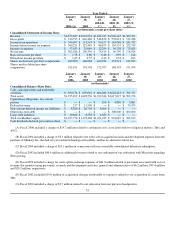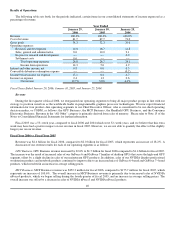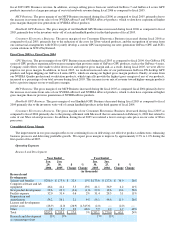NVIDIA 2006 Annual Report Download - page 39
Download and view the complete annual report
Please find page 39 of the 2006 NVIDIA annual report below. You can navigate through the pages in the report by either clicking on the pages listed below, or by using the keyword search tool below to find specific information within the annual report.
ITEM 7. MANAGEMENT'S DISCUSSION AND ANALYSIS OF FINANCIAL CONDITION AND RESULTS OF
OPERATIONS
The following discussion and analysis of our financial condition and results of operations should be read in conjunction with
“Item 1A. Risk Factors”, “Item 6. Selected Financial Data”, our Consolidated Financial Statements and related Notes thereto, as well
as other cautionary statements and risks described elsewhere in this Annual Report on Form 10−K, before deciding to purchase, hold
or sell shares of our common stock.
Overview
Our Company
NVIDIA Corporation is the worldwide leader in programmable graphics processor technologies. Our products enhance the
end−user experience on consumer and professional computing devices. We have four major product−line operating segments:
graphics processing units, or GPUs, media and communications processors, or MCPs, Handheld GPUs, and Consumer Electronics.
Our GPU Business is composed of products that support desktop personal computers, or PCs, notebook PCs and professional
workstations; our MCP Business is composed of NVIDIA nForce products that operate as a single−chip or chipset that can off−load
system functions, such as audio processing and network communications, and perform these operations independently from the host
central processing unit, or CPU; our Handheld GPU Business is composed of products that support handheld personal digital
assistants, cellular phones and other handheld devices; and the Consumer Electronics Business is concentrated in products that support
video game consoles and other digital consumer electronics devices and is composed of our contractual arrangements with Sony
Computer Entertainment, or SCE, to jointly develop a custom GPU incorporating our next−generation GeForce GPU and SCE's
system solutions in SCE's PlayStation3, sales of our Xbox−related products, revenue from our license agreement with Microsoft
relating to the successor product to their initial Xbox gaming console, the Xbox360, and related devices, and digital media processor
products.
Fiscal 2006 Developments, Future Objectives and Challenges
As we entered fiscal 2006, we had launched the GeForce 6 Series, nForce 4 MCP, and Scalable Link Interface, or SLI,
technology, with positive market reception. Our primary objective during the year was to strengthen the technology leadership
position of our GPU and MCP businesses, extend the reach of SLI technology with a broad range of compatible products, applications
and games for enthusiasts, improve gross margin beyond historical levels, and build new products and market initiatives that would be
the platform for our continued growth.
GPU Business
In February 2005, we announced the GeForce Go 6600, a mobile GPU designed specifically to deliver advanced multimedia
functionality without sacrificing portability. Also in February 2005, we introduced the GeForce Go 6800 Ultra mobile GPU.
In March 2005, we introduced two new GeForce 6 GPUs: a 512MB version of the GeForce 6800 Ultra GPU designed for the
enthusiast segment, and a new lower−cost AGP version of the GeForce 6200 GPU, designed to bring DirectX 9.0 Shader Model 3.0
technology to the mainstream segment.
In June 2005, we launched and shipped our second generation Shader Model 3.0 GPU, the GeForce 7800 GTX, which is designed
to address the high−end enthusiast desktop PC segment. In August 2005, we launched and shipped our second GeForce 7 GPU, the
GeForce 7800 GT, which is designed to address the high−end performance desktop PC segment.
In June 2005, we made our SLI technology available to users in the mainstream segment with the release of our GeForce 6600.
33
























